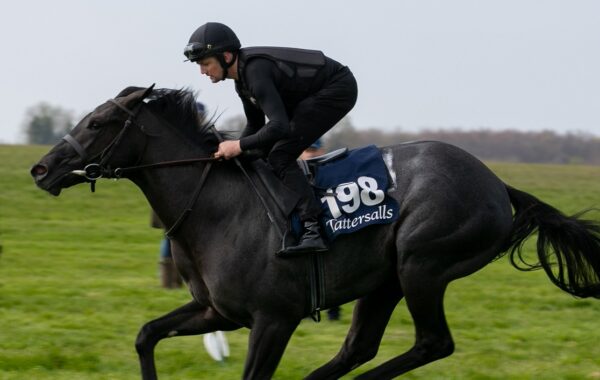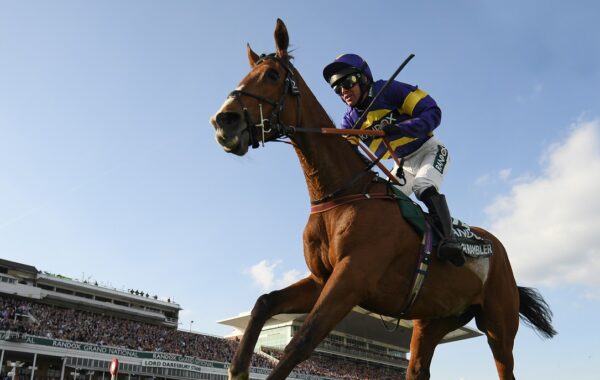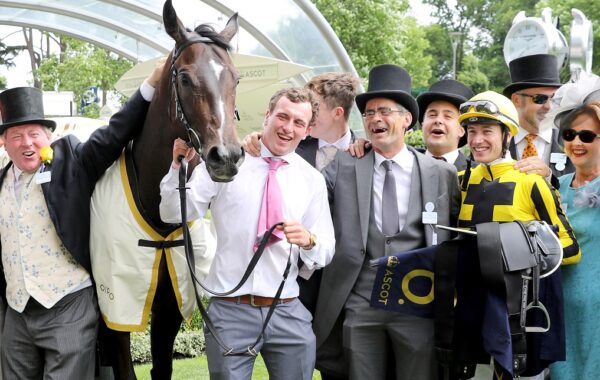You succeeded Paul Bittar as Chief Executive of the British Horseracing Authority in January. How would you describe your first nine months in the job and what have been the major challenges to date?
It’s been exhilarating. The first nine months have been about making sure I fully understand the landscape and setting a clear agenda for the BHA, working with my team on our strategic objectives, vision, mission and values, which we will publish shortly in our annual report.
It’s been a busy time – we got the fixture list out early, which was pleasing, and tackled some of the key issues facing the sport, including race planning, as well as making sure the BHA’s own operational performance is up to scratch.
Coming from a bookmaking background, what has been the biggest eye-opener since taking over at the BHA?
It’s a positive one – just how much talent exists in British racing. From the outside looking in you could be forgiven for thinking that where there is not real clarity and cohesion of purpose the talent may not exist. The talent is there across all of the organisations in our sport.
If we can galvanize that together – and the Members’ Agreement gives us a great opportunity to streamline the strategy for growth – we have a real chance of a much better future.
Talking of the different organisations in the sport, did you understand how they all came together before you took over at the BHA?
Structurally I understood how it worked and broadly I knew the various positions that were likely to be adopted, but I would have to say no, I didn’t understand the nuances of it and some of the particular hotspots and issues. But the great thing about most of the people involved in British racing is that they will tell you very quickly what their view is!
Getting out and about and meeting people in the industry was most helpful. It gave me a good feel for how the BHA was positioned. I’ve spent a lot of time with stakeholders and on the racecourse – although I’ll confess that because I live in Yorkshire, a lot of my weekend work has been at the northern and Midland tracks.
The Members’ Agreement – and it is historic – will provide a great platform for the sport to move forward
Why is it so essential for racing that the Members’ Agreement works?
The Members’ Agreement – and it is historic – will provide a great platform for the sport to move forward. Firstly, it clarifies what the British Horseracing Authority is responsible for. Sometimes we are expected to deliver in certain areas where we don’t have a mandate. Steve Harman brought in a new and exciting board and took a risk to bring in a bookie, looking to make progress.
The Members’ Agreement sets out very clearly what we have responsibility for but even more importantly, it defines the decisions we can take unilaterally, the decisions we can take after consultation and the decisions we can take with a simple majority in the three-way arrangement, or the decisions that require unanimous agreement.
The second aspect is this: there has been much talk about strategy for growth in our sport. We need that work moving forward – it is absolutely owned by the horsemen, the racecourses and the BHA.
In our own parts of the sport, yes, we obviously have certain objectives to deliver but we need a focal point that continually looks and asks, how are we getting on with British consumers, owners and betting. These are exactly the things that can be handled at a higher level through this agreement.
What happens if the members fail to reach agreement on the big issues?
The Members’ Agreement is only in place for 18 months. It can be terminated after that time. One of the things that could contribute to one of the parties giving notice is the failure to agree a memorandum of understanding about fixtures and the development of the sport. So we have to work together for the future of the sport; that will keep us focused on making progress quickly.
You have spoken about racing needing a “wider and more ambitious view” on the fixture list. What do you mean by this?
Well, 70% of the fixture list no one would change. These are fixtures in the right places on the right days with the right geographical distribution, and they work economically for the racecourses concerned. However, there is a part of the fixture list where we should challenge ourselves and ask what incentives there should be for racecourses to compete more over certain fixtures, to take slots that suit a slightly different focus.
In terms of the maximum size of the fixture list, we’re pretty close to it now with the current horse population. Next year, with a £4m cut in levy funding due, we must considered a reduction in the number of races so we can maintain minimum values to horsemen.
Will the ownership of fixtures be tested in a court of law?
I don’t think it will happen. It would be destructive. The issue we need to discuss around fixtures is how they are allocated in future and how we might achieve change to meet our sport’s needs. If we are to hit the big targets we need to look at the funding model and how it supports what we intend to do, to make sure racecourses – who do have beneficial rights in fixtures – are incentivised to make changes that the leaders of the sport agree are the right way forward.
The consultation over a holistic approach to race planning is ongoing. Can you explain what this actually means?
We are inviting an ideal view from horsemen, asking what they would like to see. In addition, we are doing a piece of data-led work with external organisations that have real expertise to find out how can we best match opportunities with the horses concerned. We need to find a balance that provides aspiration but also caters for the smaller owner.
Instead of individual racecourse groups or parts of racing planning on their own, we want to bring all of the key factors together and plan an approach that suits the strategically-led direction of the sport, with particular reference to the horse population.
Can racing persuade the betting industry that the racing right is in the best future interests of both parties?
Yes. There is a real opportunity at the moment. Everyone wants certainty. Looking at crowds, runners and betting away from the big meetings, changes there could make a big difference to the sport at grassroots level and to prize-money. All of which helps the sustainability and development of horseracing.
The levy system no longer works for the purpose it was initially intended for. It still carries out important functions but it is not capturing a portion of all money bet on British racing. We are arguing for an outcome through the racing right that delivers that. Moving to a world where all betting operators pay and looking at the fixture list overall, if we go back to the aims of growing attendances, consumer interest, horses in training and betting, we need to make some significant changes over the next five years.
The 1,000 extra horses in training is not simply about breeding; it’s about retention and development of ownership
How can the BHA try to stimulate production of racehorses in the UK – targeting 1,000 extra horses in training by 2020 – against a backdrop of increasing fixtures and a declining horse population?
I need to explain this clearly, having said we need 1,000 new horses in training. It’s really meant to be an indicator about the number of owners in the sport, so you are more likely to keep a horse in training if you have opportunities to run, the economics work better for you and you have a great experience.
It’s not simply about breeding; it’s about retention and development of ownership. Breeding will follow the demand. I would like to see an extra 1,000 horses in training by 2020.
Having worked only in bookmaking prior to your current appointment, has your opinion of the betting sector changed after your time at the BHA?
No. I have the greatest respect for my former colleagues – they have to be incredibly innovative and adaptive. They are competitive and good businessmen and the current crop is more enlightened than a few years ago. They are more willing to work on a commercial win-win solution on a number of things; I fully expect further progress will be made in the coming months.
So you don’t feel, as some do, that bookmakers have milked racing for all its worth over many years, helping them to build the multi-million pound businesses we see today?
In my view, the bookmaker lobby was extremely strong for a long time. They were well organised, together on the key issues and they had friends in parliament because they worked hard at it. In British racing, having sat in the other group for a long time, you could clearly see that was not happening here; there were individuals contradicting each other and failing to get a clear message to government. For the last two years racing has spoken with one voice. If we kick towards the same targets we will achieve.
Why launch a Horseracing Bettors Forum and can it make a difference to the sport? What punter-friendly initiatives will you be rolling out?
There are a number of things being looked at, including information to punters, race distances, going reports, making sure we adhere to the rules. They are also looking at wider matters. Some initiatives pre-date the Forum, as they came through on the betting pillar.
One thing we are looking at improving is Thursday evening racing, which is a fallow evening for the bettor, especially when the Europa League games are on. We want to build a better night’s racing and an opportunity that would attract wider media coverage, perhaps with a new bet related to it. Better harmonisation of race times with Ireland is also being looked at. We don’t regulate starting prices but we have submitted a view to the recent review, as has the Horseracing Bettors Forum.
Earlier this year you completed a series of industry roadshows in which you provided an introduction to a ‘Strategy for Growth’. Where will the resources come from to deliver some of the big ideas you mentioned?
There are existing resources from the likes of REL and GBR to support this. For the bigger projects we will seek external funding, targeting a multi-million pound pot. We need to develop the data that the sport has to engage sponsors and major brands. Those areas need investment.
We want to provide a platform for those betting operators that do have a sense of partnership so they are rewarded fully
It was announced recently that only bookmakers paying a sum on behalf of their digital businesses will be allowed to sponsor in British racing. What benefits will they receive if they opt in?
We want to provide a platform for those betting operators that do have a sense of partnership so they are rewarded fully. Those that opt in will receive a kite mark, identifying them as an ‘authorised betting partner’. There will be promotion and marketing of betting on British racing coming from the additional funds raised. They will have access on racecourses to data and wifi, sponsorship, preferential rates on media streaming and media rights.
From operating at a surplus, the BHA recorded a deficit of £1.3 million in its latest accounts. How do you envisage BHA charges on owners and licensed personnel in the future?
There were no fee increases between 2011 and 2014. That built up a deficit while other projects were being taken on. We increased fees by more than 5.8% last year – it was accepted by our participants’ representatives on the basis that there would be no more than a 3% fee increase in 2016. I want to keep the burden on participants as low as possible but at the same time I must have a viable organisation. We are looking at initiatives to attract revenue through our website to see if we can balance the books that way.
We have seen seismic changes in the betting world, with the mergers of Ladbrokes and Coral and Paddy Power and Betfair. With your intimate knowledge of the industry, did you see this coming and what are the implications for racing?
Consolidation was inevitable. The Ladbrokes and Coral merger does not surprise me, there is a good set of synergies there and I think we’ll see a stronger company moving forward. They contribute about the same amount to the sport. Of course Betfair signed a five-year deal with British racing to deliver the equivalent of levy payments until March 2017, whereas Paddy Power has refused to acknowledge that there is any duty on them. It will be fascinating to see the philosophy of the merged organisation. It’s key that Breon Corcoran shows some leadership in that respect.
What is your view on the recent news that RMG and SIS are joining forces with a five-year deal on the supply of pictures and data to betting shops?
It’s great news. There was a strong market competing for RMG’s rights. That market can only be backed by the end operators, which are the betting shops. Given there is a benefit to bookmakers in reducing distribution costs, there is also a benefit in the payments made to racecourses, which is good for racing. The longevity of the deal – combined with the Ladbrokes-Coral merger, which will have about 65% of its profits initially in British betting shops – shows that there is life in high street betting yet.
I signed the Turf TV deal at Coral, however one of the problems was the split presentation in shops. This offers hope that British racing can be better presented alongside other betting products, rather than split screens, fragmented coverage and poor sound. We’ve had this problem for eight years and I personally think it is one of the reasons why racing’s popularity in betting shops has declined.
Where would you like the BHA and British racing to be in five years’ time?
I’d like the BHA to be seen as being in tune with British racing, playing a leadership role on government matters, acting as a catalyst on the strategy for growth, and being absolutely competent and credible in its core roles around regulation, integrity and race planning.
The industry targets have been stated – a healthier ownership profile that leads to an extra 1,000 horses in training by 2020, growth in betting [5% by 2018 and 10% by 2020] and racecourses attendances north of seven million.
Closing statement?
I want the BHA to be open and transparent. I am keen that this becomes a more humble organisation, rather than defending our actions at all costs. If we make a mistake we should admit it and explain what we intend to do about it.






